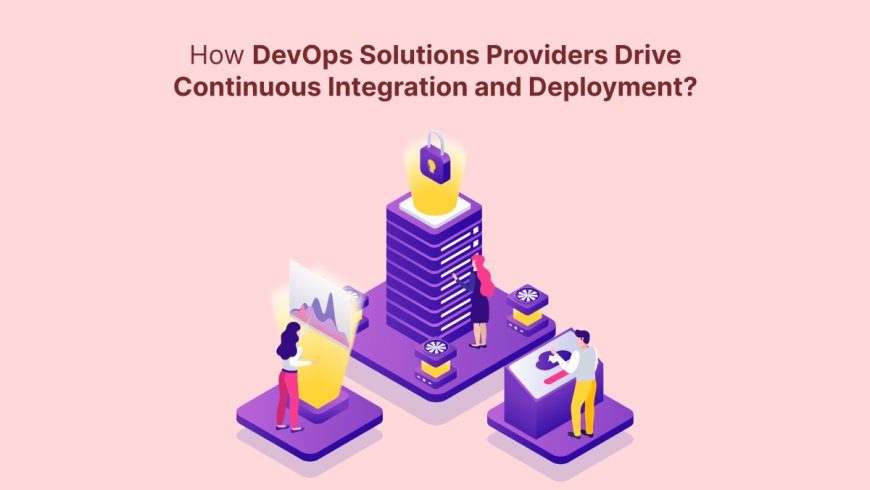How DevOps Solutions Providers Drive Continuous Integration and Deployment?
Learn how DevOps solutions providers enable continuous integration and deployment to streamline workflows, reduce errors, and accelerate delivery cycles.

Introduction: The Evolving Demands of Modern Software Delivery
In todays fast-paced digital world, software development is no longer a slow, linear process. Customers expect regular updates, businesses demand faster go-to-market strategies, and developers need efficient systems to keep up. Thats where DevOps solutions providers play a crucial roleby helping companies adopt Continuous Integration (CI) and Continuous Deployment (CD) practices that streamline software delivery and increase agility.
CI/CD isnt just a buzzword. Its a structured approach that automates how code is built, tested, and delivered to production. Done right, it speeds up releases, reduces errors, and improves collaboration across teams. But implementing and maintaining a proper CI/CD system requires deep expertise and the right toolsthis is where DevOps solutions providers come in.
In this blog, well explore how these experts drive the adoption and success of CI/CD pipelines and how this transformation helps businesses stay ahead of the curve.
What Are DevOps Solutions Providers?
DevOps solutions providers are specialized companies or teams that help organizations build, manage, and optimize their DevOps practices. Their services often include infrastructure automation, CI/CD setup, monitoring, security integration, and consulting.
These providers assess your current development and deployment workflows and create strategies to improve efficiency, reduce time to market, and ensure reliable software releases. They also bring technical knowledge in modern tools like Jenkins, GitLab, CircleCI, Kubernetes, Docker, and various cloud platforms.
What Is Continuous Integration and Continuous Deployment?
Before diving deeper, lets define what CI and CD mean.
- Continuous Integration (CI) is a practice where developers frequently merge their code changes into a shared repository, often several times a day. Each integration is automatically tested to catch bugs early.
- Continuous Deployment (CD) takes this further by automatically deploying the tested code into production or staging environments. This enables rapid releases with minimal manual intervention.
Together, CI/CD practices make software delivery faster, safer, and more reliable.
Why CI/CD Matters for Business Success
Faster Release Cycles
With CI/CD, businesses can release new features, updates, and bug fixes more frequently. This helps them respond quickly to market trends and user feedback.
Improved Product Quality
Automated testing and validation reduce human error and catch bugs earlier in the development process, leading to a more stable and high-quality product.
Better Collaboration
CI/CD encourages shared responsibility across developers, testers, and operations teams. This improves transparency and speeds up issue resolution.
Reduced Deployment Risks
Frequent, smaller updates are less risky than large, infrequent releases. With CI/CD, issues can be rolled back or fixed faster, minimizing disruption.
DevOps solutions providers make all this possible by designing, implementing, and optimizing CI/CD pipelines tailored to your needs.
How DevOps Solutions Providers Enable Continuous Integration
Setting Up Version Control and Branching Strategies
CI starts with proper version control using tools like Git. DevOps providers establish standardized workflows such as GitFlow, trunk-based development, or feature branching to keep code organized and collaboration smooth.
They also implement access controls and review mechanisms to maintain code quality and security.
Automating Builds
Every time a developer pushes code, the system automatically triggers a build process. This might include compiling code, bundling resources, and preparing the software for testing.
DevOps experts configure build servers like Jenkins, Bamboo, or GitHub Actions to run these builds efficiently. This automation saves time and ensures consistent results.
Integrating Automated Testing
Testing is critical in CI. DevOps solutions providers implement various automated testsunit, integration, UI, and API testsinto the pipeline. This ensures that every code change is validated quickly and issues are caught early.
They also set up test reporting dashboards so teams can see pass/fail results and act accordingly.
Code Quality and Security Checks
To improve code quality and prevent vulnerabilities, CI pipelines often include static code analysis, linting, and security scans. DevOps providers configure tools like SonarQube or Checkmarx to ensure code meets standards before moving forward.
These checks create a layer of confidence and reduce the chances of production issues.
How DevOps Solutions Providers Drive Continuous Deployment
Automated Deployments to Staging and Production
Once code is tested and verified, CD automates its deployment to target environments. DevOps providers configure deployment scripts and use tools like Helm, Spinnaker, or Argo CD to orchestrate rollouts.
These systems can handle multi-environment deployments (like dev, test, and production), reducing manual steps and ensuring consistency.
Rollback and Recovery Mechanisms
Sometimes, things go wrong in production. DevOps providers set up rollback strategies like blue-green deployments or canary releases. These methods allow new versions to be released to a small subset of users first and rolled back if issues are found.
This safeguards user experience and builds trust in the deployment process.
Monitoring and Alerts
Deployment doesnt end with release. Continuous monitoring ensures that the application behaves as expected. DevOps teams implement tools like Prometheus, Grafana, New Relic, or Datadog to monitor application health, usage, and error rates.
If anomalies are detected, alerts are triggered so the team can act quicklypreventing prolonged downtime.
Integrating Feedback Loops
CD pipelines include mechanisms for collecting user feedback, system logs, and error reports. DevOps experts configure systems to automatically feed this data back to developers, allowing them to make improvements and close the loop.
Real-Life Examples of CI/CD in Action
- A fintech startup improved its release cycle from bi-monthly to daily after adopting a CI/CD pipeline managed by a DevOps provider. This allowed them to test new features quickly and win early feedback from users.
- A retail company dealing with high online traffic partnered with a DevOps firm to implement automated rollbacks during peak sales events. This saved them from potential revenue loss due to downtime during Black Friday.
- A healthcare app provider integrated continuous testing and deployment, resulting in better compliance with health regulations and fewer release-related incidents.
These examples show how professional DevOps solutions can drastically improve development velocity and business outcomes.
Read more: How DevOps Support Services Transform Your IT Operations for Maximum Efficiency?
Choosing the Right DevOps Solutions Provider
Industry Experience
Look for providers who understand your domain and its regulatory, security, and compliance requirements.
Tool Proficiency
A strong DevOps partner should be proficient in a wide range of CI/CD tools and platforms. Ask about their certifications and technology partnerships.
Customization and Flexibility
The best solutions are never one-size-fits-all. Choose a provider who builds pipelines that align with your teams workflows and business goals.
Support and Training
Implementation is just the start. Ensure the provider offers ongoing support, training, and optimization to keep your pipelines healthy and evolving.
Conclusion
Continuous Integration and Continuous Deployment are essential components of modern software development. They allow businesses to release high-quality products faster, reduce manual work, and improve collaboration across teams. But adopting CI/CD successfully requires more than just toolsit needs expertise, strategy, and continuous support.
Thats exactly what DevOps solutions providers offer. From setting up version control and automated testing to managing deployments and monitoring post-release, they create end-to-end systems that keep your software delivery engine running at full speed.
By working with a trusted app development company that also understands DevOps practices, your business gains a powerful edgefaster releases, better product quality, and the agility to grow in a dynamic marketplace.
Frequently Asked Questions
What is the main benefit of using DevOps solutions providers for CI/CD?
They bring the technical expertise and experience needed to implement reliable, automated pipelines that speed up development and reduce deployment risks.
Can DevOps solutions work with existing development tools?
Yes, DevOps providers integrate CI/CD tools with your current environment, including version control, issue tracking, and cloud platforms.
How long does it take to set up a full CI/CD pipeline?
It depends on project complexity, but initial setups can often be completed within a few weeks, with continuous improvements over time.
Is CI/CD suitable for non-technical teams?
While it's a technical process, non-technical stakeholders benefit too through faster updates, more stable releases, and better visibility into project progress.
What role does monitoring play in CI/CD?
Monitoring ensures that deployed applications are running correctly. It helps detect errors early, maintain uptime, and continuously improve system performance.











































